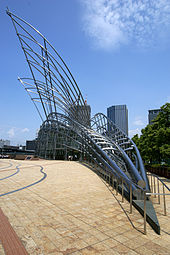National Museum of Art, Osaka

The National Museum of Art (国立国際美術館, Kokuritsu Kokusai Bijutsukan) is a subterranean Japanese art museum located on the island of Nakanoshima, located between the Dōjima River and the Tosabori River, about 5 minutes west of Higobashi Station in central Osaka.
The official Japanese title of the museum translates as the "National Museum of International Art". The museum is also known by the English acronym NMAO (National Museum of Art, Osaka).
NMAO history[]
Designed by architect Arata Isozaki. The museum originates from the Expo Art Gallery which was built as part of Expo '70, held in Suita in the outskirts of Osaka. The site was converted into Expo Commemoration Park after the Expo, but the gallery was preserved for possible future use as a permanent art museum. It re-opened in 1977 as the National Museum of Art, as part of the Expo Commemoration Park. Due to the aging of the building as well as growing space limitations, the museum was temporarily closed in January 2004. The old museum was demolished and turned into a car park, while the exhibits were transferred to its more central, current location in Nakanoshima, which opened in November 2004.
NMAO collections[]
Most of the artwork in the collection is from the post-war era. Pre-war exceptions include work by Paul Cézanne, Pablo Picasso, Max Ernst, Tsuguharu Foujita and Yasuo Kuniyoshi.
Pelli's building[]
The museum structure is itself an example of the modern architect's art. The present museum was designed by international architect César Pelli. Most of the museum facilities are located underground, next to the Osaka Science Museum. Pelli suggested that the externally visible design structure represents waving reeds in the wind.[1]
The entrance, auditorium, restaurant and the museum shop are located just beneath ground level, with exhibits and storage facilities on the next two floors beneath. Permanent exhibition space and artist-focused temporary exhibits are located in the intermediate level, and various changing exhibitions are mounted in the lowest level.
Union catalog[]
The Union Catalog of the Collections of the National Art Museums, Japan, is a consolidated catalog of material held by the four Japanese national art museums—the National Museum of Modern Art in Kyoto (MOMAK), the National Museum of Modern Art in Tokyo (MOMAT), the National Museum of Art in Osaka (NMAO), and the National Museum of Western Art in Tokyo (NMWA):[2]
- National Museum of Modern Art, Kyoto (MOMAK).[3]
- National Museum of Modern Art, Tokyo (MOMAT)
- National Museum of Art, Osaka (NMAO)
- National Museum of Western Art (NMWA)
The online version of this union catalog is currently under construction, with only selected works available at this time.[2]
Selected artists[]
|
|
See also[]
- List of Independent Administrative Institutions (Japan)
References[]
- ^ Crosbie, Michael C. (2013). Pelli Clarke Pelli Architects. Birkhäuser. p. 44. ISBN 978-3-0346-0870-1.
- ^ Jump up to: a b IAI-National Museums of Art union catalog, Japan.
- ^ MOMAK union catalog, Japan.
External links[]
| Wikimedia Commons has media related to The National Museum of Art, Osaka. |
- National Museum of Modern Art, Osaka web site
- Independent Administrative Institution National Museum of Art (in Japanese)
Coordinates: 34°41′30″N 135°29′31″E / 34.691786°N 135.492024°E
- Art museums established in 1977
- 1977 establishments in Japan
- Art museums and galleries in Japan
- National museums of Japan
- Art museums and galleries in Osaka
- César Pelli buildings
- Expo '70
- World's fair architecture in Japan
